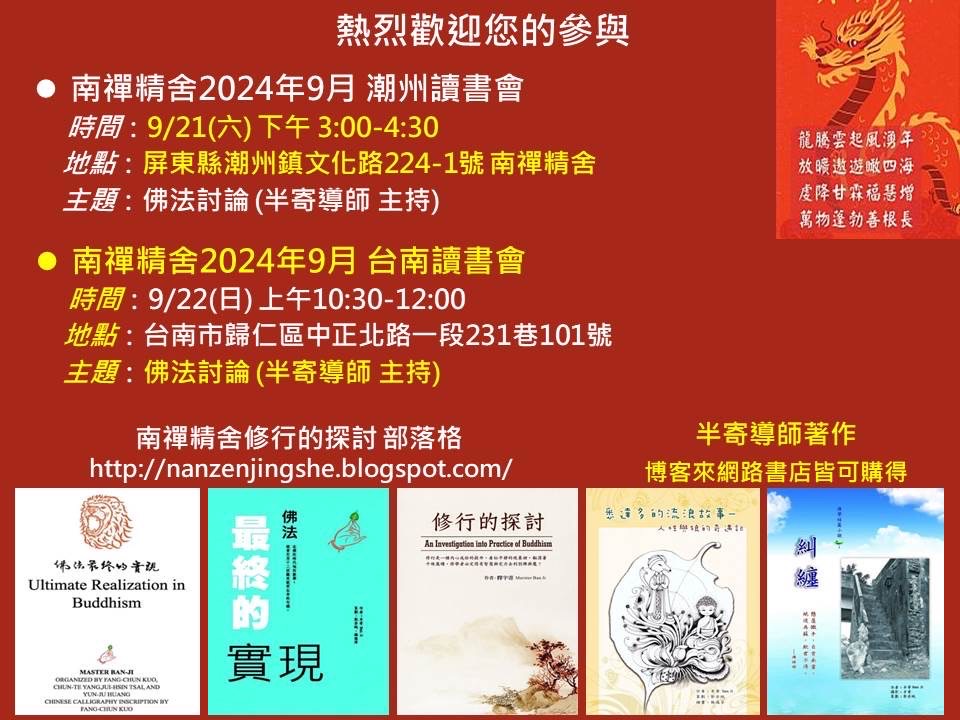許多看不到南禪佛法文章的朋友,想方設法來看,激勵我再寫此篇。
Friends of NanZen!
This essay is for all those who haven’t been able to read some of my articles published by NanZen.
讀書會4
Book club 4
《中觀論》用了「不來不去」闡述時間與運動的「空」觀點。
近代科學認為時間、空間是一致的故用「時空」一詞。
在天文的星星爆炸研究中,認為古代星體的爆炸至今可見,
假設;我們曾生活在明代至今還有明代的福與障那是否代表我們個人的肉體、個人的遭遇中還有明代的時空力量牽制?
這樣一想跟明代有牽連的「曾經」似乎還沒完全燃燒完!
In the Mūlamadhyamakakārikā (Fundamental Verses on the Middle Way), the expression “no coming, no going” describes emptiness in terms of time and motion.
Modern physics sees time and space as identical, hence the term “time-space.”
Astronomers claim that stars that exploded in the distant past can still be seen today.
Looking at it from the perspective of karma and rebirth, all of the good and bad karma you made in a past life 300 years ago is still with you, in your body and in all the fortune and misfortune you encounter; i.e., it’s contained in the space-time energy initiated 300 years in the past.
Looking at it this way, the events of 300 years ago are still having an effect in the present.
《解讀龍樹菩薩〈中論〉27道題》第20頁「佛陀的確說過,今生的某人和轉世的此人是『不一亦不異』。」
我個人的講解裡也曾說;如果每一刻的你都是存在著,那是不可能的事情。
(用生滅、擠的、壓縮的都不可能)
那每一刻的你如果不存在又當如何?(哈!這探討費了分分秒秒的時光)
On page 20 of the Chinese translation of Nāgārjuna’s Middle Way, an annotated translation of the Mūlamadhyamakakārikā (Treatise on the Middle Way), we read that the relationship between who you are now and who you were in a previous life is best described as “neither the same nor different.” The way I explain it is that who you are at one point in time is not an eternally self-existent entity, so there’s no individual that can be preserved or held onto by any means whatsoever.
Now, what are the practical implications of this doctrine? (Ha! Practitioners are completely immersed in time-light when cultivating not-self.)
時間與空間於佛法而言必須帶入業(福與障),這人群中的糾葛就夾雜與交錯時間跟空間,所以是另一種觀點。
一部簡短的《中觀論》論述了無我、時間、空間、福、業、修持內容的「空」觀點,
我個人也是從看到無字天書的迷茫中探討起來,
隨著時代中觀空的思想研究越見高明,佛法大幸。
半寄
From the Buddhist perspective, any discussion of time and space has to consider karma, both positive and negative. Karma is inextricably bound up with time and space, so it’s a whole other way of looking at it.
This concise Treatise on the Middle Way discusses emptiness from the perspectives of not-self, space, time, merit, karma, and spiritual practice.
My own approach has been to enter into a dialogue with these often-abstruse materials. Fortunately for students of the Buddhadharma, these days there are an increasing number of good books elucidating the doctrine of emptiness in the Treatise on the Middle Way.
Master Ban Ji
Translated by Ken Kraynak






.JPG)



